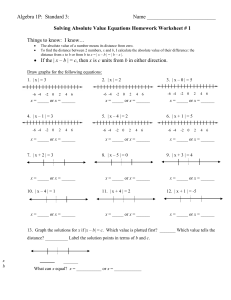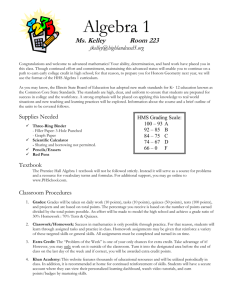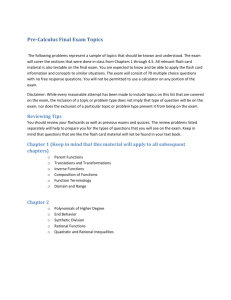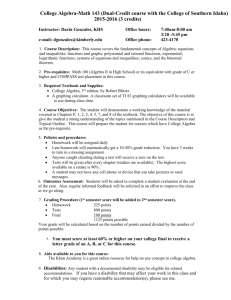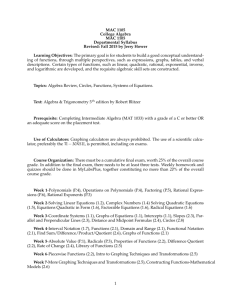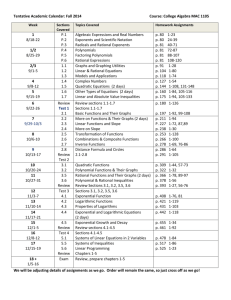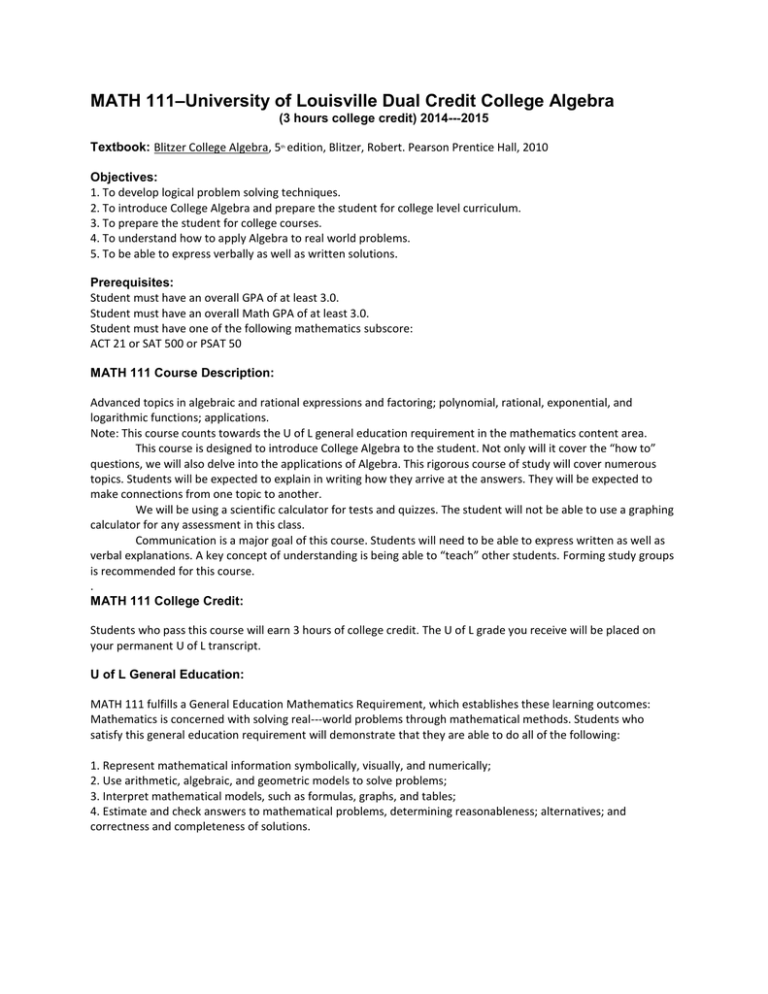
MATH 111–University of Louisville Dual Credit College Algebra
(3 hours college credit) 2014--‐2015
Textbook: Blitzer College Algebra, 5 edition, Blitzer, Robert. Pearson Prentice Hall, 2010
th
Objectives:
1. To develop logical problem solving techniques.
2. To introduce College Algebra and prepare the student for college level curriculum.
3. To prepare the student for college courses.
4. To understand how to apply Algebra to real world problems.
5. To be able to express verbally as well as written solutions.
Prerequisites:
Student must have an overall GPA of at least 3.0.
Student must have an overall Math GPA of at least 3.0.
Student must have one of the following mathematics subscore:
ACT 21 or SAT 500 or PSAT 50
MATH 111 Course Description:
Advanced topics in algebraic and rational expressions and factoring; polynomial, rational, exponential, and
logarithmic functions; applications.
Note: This course counts towards the U of L general education requirement in the mathematics content area.
This course is designed to introduce College Algebra to the student. Not only will it cover the “how to”
questions, we will also delve into the applications of Algebra. This rigorous course of study will cover numerous
topics. Students will be expected to explain in writing how they arrive at the answers. They will be expected to
make connections from one topic to another.
We will be using a scientific calculator for tests and quizzes. The student will not be able to use a graphing
calculator for any assessment in this class.
Communication is a major goal of this course. Students will need to be able to express written as well as
verbal explanations. A key concept of understanding is being able to “teach” other students. Forming study groups
is recommended for this course.
.
MATH 111 College Credit:
Students who pass this course will earn 3 hours of college credit. The U of L grade you receive will be placed on
your permanent U of L transcript.
U of L General Education:
MATH 111 fulfills a General Education Mathematics Requirement, which establishes these learning outcomes:
Mathematics is concerned with solving real--‐world problems through mathematical methods. Students who
satisfy this general education requirement will demonstrate that they are able to do all of the following:
1. Represent mathematical information symbolically, visually, and numerically;
2. Use arithmetic, algebraic, and geometric models to solve problems;
3. Interpret mathematical models, such as formulas, graphs, and tables;
4. Estimate and check answers to mathematical problems, determining reasonableness; alternatives; and
correctness and completeness of solutions.
MA 111 Course Outline:
Chapter P: Fundamental Concepts of Algebra I
P.1 Algebraic Expressions, Models & Real Numbers
P.2 Exponents and Scientific Notation
P.3 Radicals and Rational Exponents
P.4 Polynomials
P.5 Factoring Polynomials
P.6 Rational Expressions
Chapter 1: Equations and Inequalities
1.2 Linear Equations and Rational Equations
1.3 Models and Applications
1.4 Complex Numbers
1.5 Quadratic Equations
1.6 Other Types of Equations
1.7 Linear Inequalities and Absolute Value Inequalities
Chapter 2: Functions and Their Graphs
2.1 Basics of Functions and Their Graphs
2.2 More on Functions and Their Graphs
2.3 Linear Functions and Slope
2.4 More on Slope
2.5 Transformations of Functions
2.6 Combinations of Functions: Composite Functions
2.7 Inverse Functions
Chapter 3: Polynomial and Rational Functions
3.1 Quadratic Functions
3.2 Polynomial Functions and Their Graphs
3.3 Dividing Polynomials: Remainder and Factor Theorem
3.4 Zeros of the Polynomial Functions
3.5 Rational Functions and Their Graphs
Chapter 4: Exponential & Logarithmic Functions
4.1 Exponential Functions
4.2 Logarithmic Functions
4.3 Properties of Logarithms
4.4 Exponential and Logarithmic Equations
Chapter 5: Systems of Equations and Inequalities
5.1 Systems of Linear Equations in Two Variables
5.2 Systems of Linear Equations in Three Variables
5.4 Systems of Nonlinear Equations in Two Variables
5.5 Systems of Inequalities
5.6 Linear Programming
Chapter 7 Conic Sections
7.1 The Ellipse
7.2 The Hyperbola
7.3 The Parabola
Chapter 8: Sequences, Induction, & Probability
8.1 Sequences and Summation Notation
8.2 Arithmetic Sequences
8.3 Geometric Sequences and Series
8.5 The Binomial Theorem
8.6 Counting Principles, Permutations, and Combinations
8.7 Probability
Grading: In this course, you will receive two grades: a High School grade and a
University of Louisville grade.
The High School grade will consist of:
40% Test – one test per 6 weeks
25% Quizzes – will be assessed periodically to check understanding of concepts. Students are encouraged to
make corrections to quizzes as the topics will be revisited on tests.
25% Homework – is assigned daily. It is guided practice and is expected to be completed thoroughly. Some
students find it helpful to rework problems to emphasize understanding. Homework is sometimes graded based on
effort and sometimes on accuracy. Students at this level should be mature enough to make it a priority to
understand the concepts. They should also seek assistance when necessary. Free math tutoring is available daily in
room N235. The goal of homework is not to just get the assignment completed; it is to understand every problem.
10% Final Exam – one will be given each semester.
The grade will be updated weekly on Infinite Campus. You will need to keep up with your passwords.
The University of Louisville grade, the grade will be given at the end of the
course.
55% Test – all tests and midterm.
10% Quizzes – average score 1st and 2nd semester.
10% Homework/Project/Investigations – average score 1st and 2nd semester.
25% Final Exam – cumulative 1st and 2nd semester.
The University of Louisville final grade will be updated every 6 weeks on Blackboard. You will need to keep up with
your passwords.

